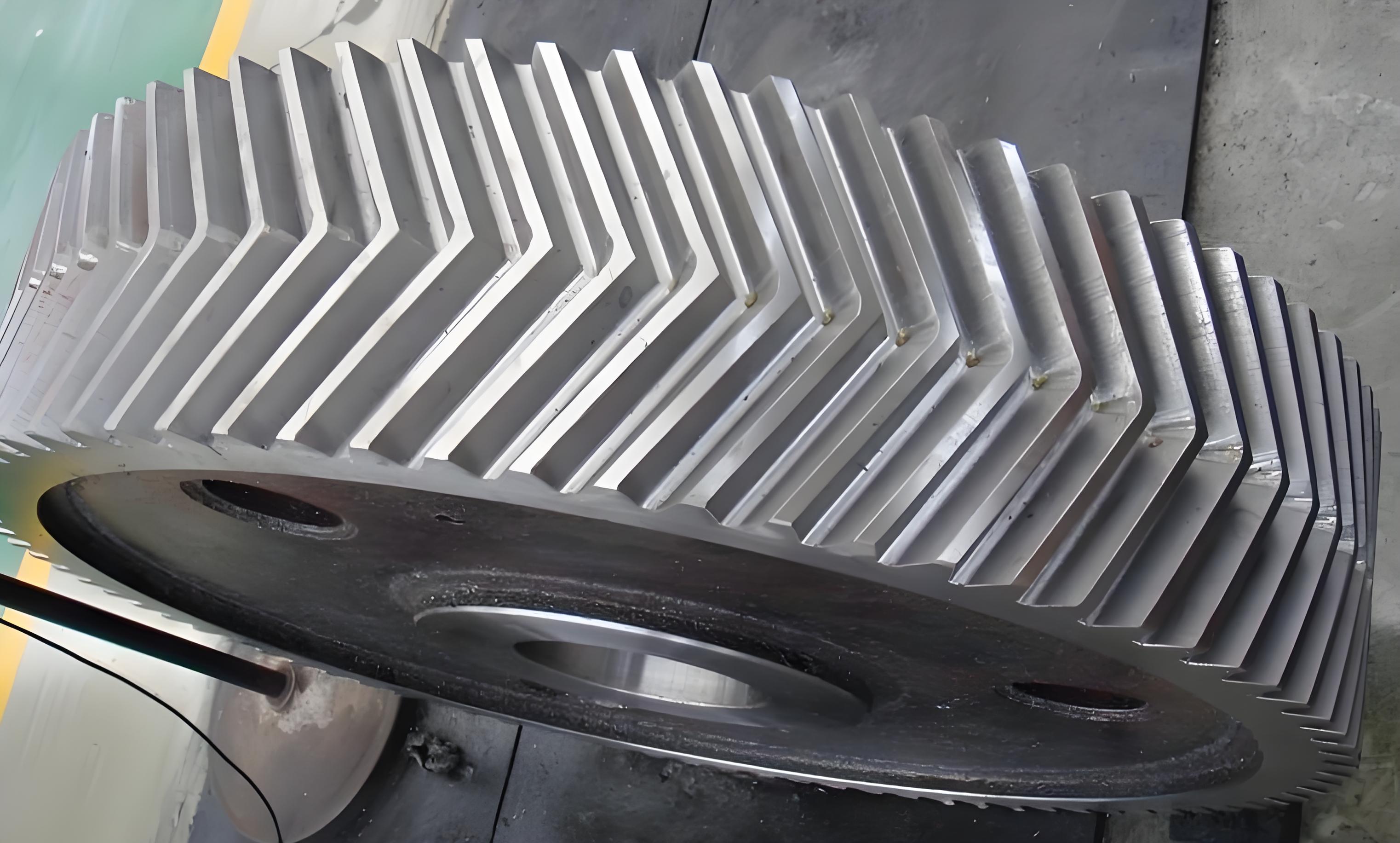Abstract
The dynamic characteristics of a two-stage herringbone gear transmission system with cracks. By establishing a mathematical model and conducting both theoretical and experimental analyses, the study explores the impact of cracks on the time-varying meshing stiffness and vibration response of the system. The findings provide a theoretical basis for fault diagnosis in gear transmission systems.

1. Introduction
The two-stage herringbone gear transmission system is widely used in marine engines due to its strong load-carrying capacity and efficient torque transmission. However, under high-speed and heavy-load conditions, cracks may occur in the gear teeth, affecting the normal operation of the gear system. Therefore, studying the dynamic characteristics of herringbone gears with cracks is crucial for maintaining the smooth operation of equipment.
2. Mathematical Model Establishment
2.1 Simplification of Herringbone Gear Teeth
In this study, the herringbone gear teeth are simplified as a cantilever beam model, considering factors such as bending, shear, axial compression, and contact.
Table 1: Factors Considered in the Cantilever Beam Model
| Factor | Description |
|---|---|
| Bending | Bending deformation of the gear teeth |
| Shear | Shear deformation of the gear teeth |
| Axial Compression | Axial compression of the gear teeth |
| Contact | Contact force between the gear teeth |
2.2 Calculation of Time-Varying Meshing Stiffness
The potential energy method is used to calculate the time-varying meshing stiffness of the herringbone gear with cracks. By analyzing the influence of crack length, depth, and angle, the variation of time-varying meshing stiffness is obtained.
Table 2: Influence of Crack Parameters on Time-Varying Meshing Stiffness
| Crack Parameter | Description | Impact on Time-Varying Meshing Stiffness |
|---|---|---|
| Length | Length of the crack in the gear tooth | Decreases as the crack length increases |
| Depth | Depth of the crack in the gear tooth | Decreases as the crack depth increases |
| Angle | Angle of the crack in the gear tooth | Varies depending on the crack angle |
3. Dynamic Model of Two-Stage Herringbone Gear Transmission System
A 48-DOF (degrees of freedom) bending-torsion-axis-pendulum dynamic model is established for the two-stage herringbone gear transmission system, considering internal and external excitation factors such as time-varying meshing stiffness, errors, torsional stiffness, support stiffness, tooth surface friction, and receding grooves.
Table 3: Excitation Factors Considered in the Dynamic Model
| Excitation Factor | Description |
|---|---|
| Time-Varying Meshing Stiffness | Variation of meshing stiffness over time due to cracks |
| Errors | Manufacturing and installation errors in the gear system |
| Torsional Stiffness | Stiffness of the shafts and gears in torsion |
| Support Stiffness | Stiffness of the bearings and supports in the gear system |
| Tooth Surface Friction | Friction between the mating surfaces of the gear teeth |
| Receding Grooves | Geometric features of the gear teeth that affect meshing behavior |
4. Theoretical and Experimental Analysis
4.1 Theoretical Analysis
The dynamic differential equations of the two-stage herringbone gear system are derived using Newton’s mechanical laws. The fourth-order Runge-Kutta numerical integration method is adopted to solve the differential equations and obtain the vibration response and dynamic characteristics of the gear train.
4.2 Experimental Setup
A vibration test rig for the two-stage herringbone gear transmission system is built to test the effect of different crack lengths on the vibration response. Accelerometers are used to measure the vibration acceleration signals of the gear system.
Table 4: Experimental Setup for Vibration Testing
| Component | Description |
|---|---|
| Gear Processing | Manufacturing of herringbone gears with different crack lengths |
| Test Rig Structure | Assembly of the gear system, bearings, supports, and sensors |
| Test Procedure | Steps for conducting the vibration response test |
| Accelerometers | Devices used to measure vibration acceleration signals |
4.3 Comparison of Theoretical and Experimental Results
The theoretical simulation results are compared with the experimental results to confirm the reliability of the theoretical research approach. The study finds that as the tooth root crack increases, the time-varying meshing stiffness decreases, and there is a shocking phenomenon in the time-domain response. Additionally, small spurious frequencies appear near the sub-frequency and increase as the crack expands.
5. Discussion
The study reveals that cracks in herringbone gears significantly affect the time-varying meshing stiffness and vibration response of the two-stage gear transmission system. The findings can be used to diagnose faults in gear transmission systems and provide guidance for gear design and maintenance.
6. Conclusion
Comprehensive study on the dynamic characteristics of a two-stage herringbone gear transmission system with cracks. By establishing a mathematical model, conducting theoretical and experimental analyses, and comparing the results, the study provides valuable insights into the impact of cracks on gear performance. The findings contribute to the fault diagnosis and maintenance of gear transmission systems, ensuring their smooth and efficient operation.
